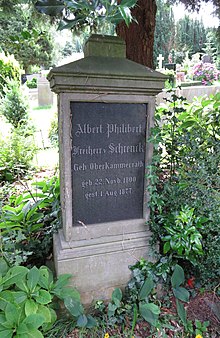Albert Philibert Schrenck from Notzing

Albert Philibert Freiherr von Schrenck , also Schrenck von Notzing (born November 22, 1800 in Aurich , † August 1, 1877 in Oldenburg ), was a German senior geometer and senior chamber councilor of the Grand Duchy of Oldenburg .
Life
Schrenck came from the North German branch of the Munich patrician family Schrenck von Notzing , who had been raised to the rank of baron in 1719. His father, the grandson of the founder of the North German branch of the family, was Franz Xaver Schrenck von Notzing (1776–1860), who worked in East Friesland as Rendant of the intelligence fund, that is, the funds for the creation of the local intelligence papers .
Albert Philibert Schrenck attended the Ulricianum grammar school and received mathematics lessons from Jabbo Oltmanns in Emden in 1816/17 . Under Oltmann's direction, Schrenck subsequently contributed to the triangulation and mapping of the Ems river basin . At the University of Göttingen he became a student of Carl Friedrich Gauß , who, since he was also involved in land surveying, trained him further in the theory and practice of surveying. In 1820 Schrenck passed his exams and entered the service of the Prussian surveying and cadastral system. He initially worked in the Münster administrative district and from 1824 was one of the trigonometers that recorded 1st and 2nd order triangular networks in the Rhineland and Westphalia .
Through the mediation of his college friend Carl Heinrich Edmund von Berg , he took over the management of the land survey for the establishment of the property tax cadastre of the Grand Duchy in Oldenburg in 1834 as a geodetic . Schrenck obtained the results of his Hanover grade measurement from his former teacher Gauß and made them usable for his assignment in Oldenburg. After triangulation and parcel surveying of the Grand Duchy, over 3000 land maps were created , as well as parish maps, a river and path map on a scale of 1: 100,000 in three sheets, a topographic map work in a scale of 1: 50,000 in 14 sheets and a general map in a scale of 1: 200,000. With these maps Schrenck made important sources available for studying the development of Oldenburg's settlement history. Based on his work, the property tax cadastre was introduced in the Grand Duchy in 1866 with the enactment of the relevant laws.
In 1865 the Grand Duchy of Oldenburg joined the Degree Measurement Commission , an international agreement to research the shape of the earth. Schrenck was appointed commissioner for this.
family
Schrenck was married twice. On May 25, 1823 he married Johanna Magdalena geb. van Nes (1803–1846), the daughter of the lawyer Theodor Christian van Nes and Susanna Catharina born. Ploos van Amstel. After her death, on February 8, 1848, he married Amalie Alexandrine von Weddig (1808–1879), the daughter of Major Christian August von Weddig (1772–1826) and Catharina Eleonore née. by Ompteda . Nine children came from these marriages, of which Wilhelm Philibert (1828-1892) became Lord Mayor of Oldenburg.
literature
- Hans Friedl: Schrenck, Albert Philibert Freiherr von. In: Hans Friedl u. a. (Ed.): Biographical manual for the history of the state of Oldenburg . Edited on behalf of the Oldenburg landscape. Isensee, Oldenburg 1992, ISBN 3-89442-135-5 , p. 649 f. ( online ).
- Siegmund Günther : Schrenck, Albert Philibert Freiherr v. In: Allgemeine Deutsche Biographie (ADB). Volume 32, Duncker & Humblot, Leipzig 1891, p. 484.
| personal data | |
|---|---|
| SURNAME | Schrenck von Notzing, Albert Philibert |
| ALTERNATIVE NAMES | Schrenck, Albert Philibert Freiherr von (alternative name) |
| BRIEF DESCRIPTION | Geodesist and Upper Chamber Councilor of the Grand Duchy of Oldenburg |
| DATE OF BIRTH | November 22, 1800 |
| PLACE OF BIRTH | Aurich |
| DATE OF DEATH | August 1, 1877 |
| Place of death | Oldenburg (Oldb) |
